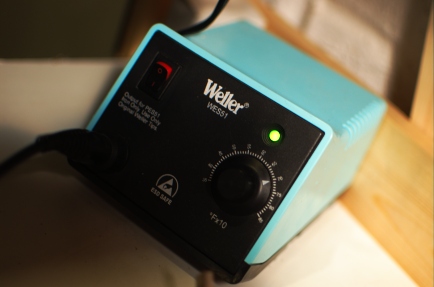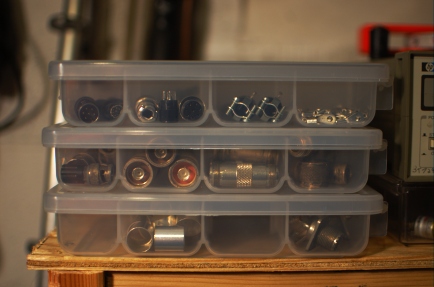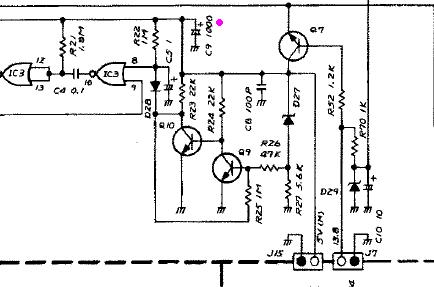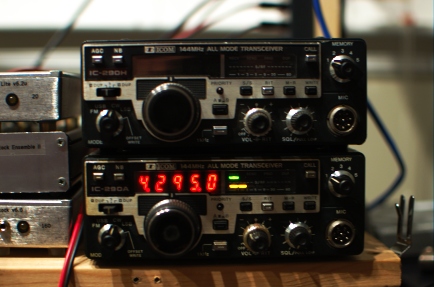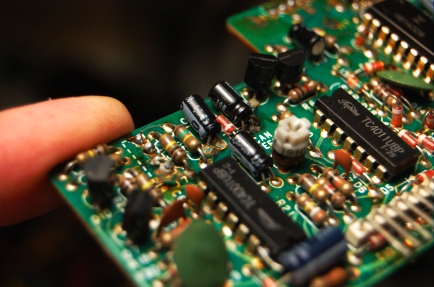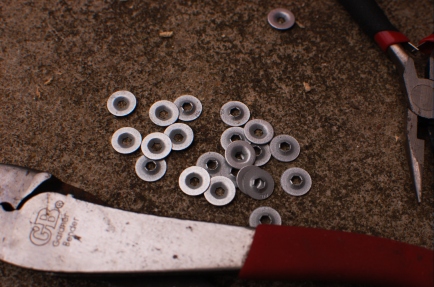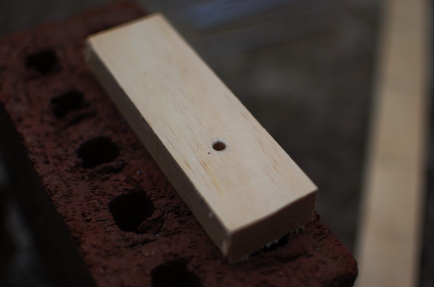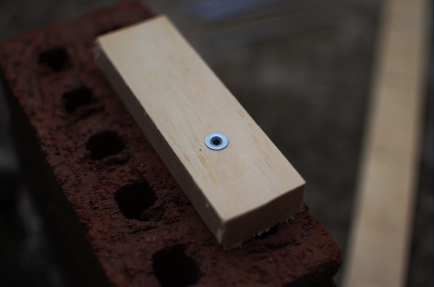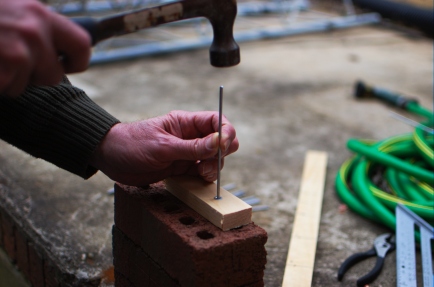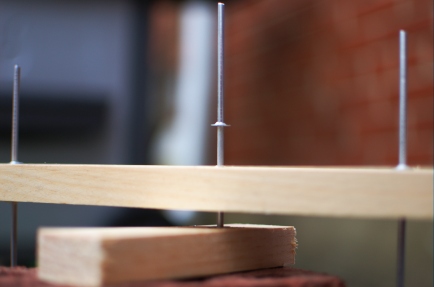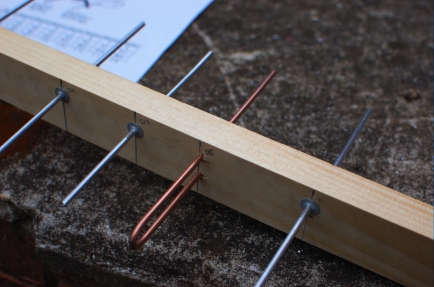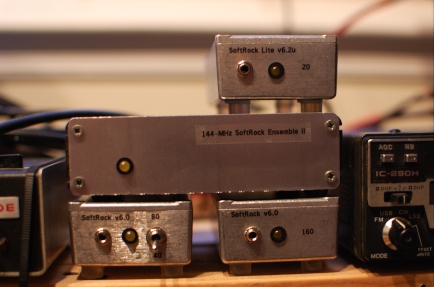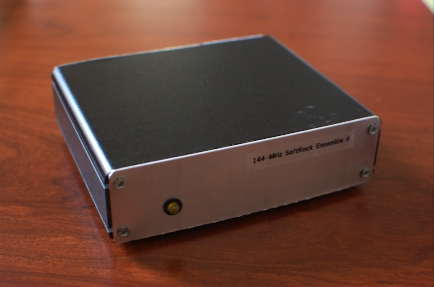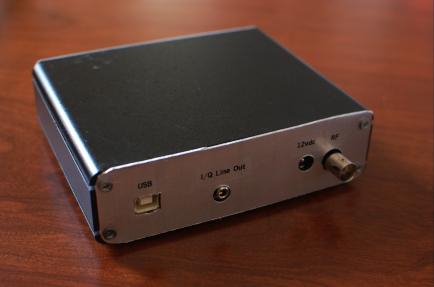Posts Tagged ‘cheap VHF’
 The Joy of Homebrew
The Joy of Homebrew
This is about building electronics, not making beer, at home; although, I am sure there are parallels. Three things brought me to writing this: 1. an eHam forum thread I responded to a few weeks ago; 2. the June 2011 issue of IEEE Microwave magazine (has articles by K2UYH, N2UO, and KK7B, perhaps others? thanks to W3KL via the PVRC reflector for bringing it to my attention since I let my IEEE/MTT membership lapse); and 3. a few minutes spent last night resuming a partially-completed Softrock kit gifted to me by a friend who decided to buy a FLEX-3000 instead.
Every once in a while, a thread appears on an amateur radio forum that goes a little bit like this, “Hi, I’m a new ham and I don’t have a lot of money to spend so I want to build an HF SSB station from scratch” or something similar. Somehow, somewhere, somebody has given the impression that it is less expensive to build your own amateur radio equipment than to buy it. That’s true in some circumstances, but certainly rarely for anything that is mature, mass-produced, and readily-available on the second-hand market. After all, there is nothing novel about a 100-watt superheterodyne HF SSB transceiver these days. The principal uncounted cost is the “engineering cost” associated with getting your first few projects working and keeping them working.
One of the first construction projects I undertook as a new ham was to build a Ramsey Electronics HR-20 (NE602-based) 20-meter receiver—$20 at a hamfest. It did actually work eventually—but this was a simple kit with maybe two dozen parts. Next, I built a ONER transmitter kit from now defunct 624 Kits. I think that was another $20. I never made any QSOs with that combination because I was always afraid of blowing out the receiver with the transmitter. The first thing that I built that I actually managed to make a QSO with was a Small Wonder Labs SW-40, which I still have. That set me back $55 and it did not work immediately. Suddenly, that’s over $100 by the time you include the money I spent on a soldering iron and solder. That’s one-third to half-way to a “real” used HF transceiver and I had two bands at 1 watt on CW only. Furthermore—these are all kits—they leverage economies of scale in purchasing parts from various vendors and they have instructions to help you along. And, I’d like to think that I was a relatively representative example of a recently-minted ham who had more ambition than money or skills…
As I soldered down 1206-size (easy ones) SMT capacitors last night, I was thinking of times that I rushed through a homebrew or kit project just to get it on the air. In those instances the process was often, as I have belabored above, about saving money, not about the act of creating something. Last night was about creating, not saving, and that is the joy of homebrew.
 More on IC-290A disappearing display
More on IC-290A disappearing display
See original post here. Convinced that I had it working, I put the IC-290A aside and worked on some other projects. But, when I came back to it a few weeks later, the display was still disappearing. So, armed with the schematic and the block diagram, I began narrowing it down.
The display digits and tuning A/D converter are both driven off the same bus. But, since the disappearance of the display did not bring loss of receive, that gave me some confidence that it was not affecting the synthesizer. In order to simplify the analysis, I elected to assume that it was a single component (almost certainly a cold solder joint or an electrolytic capacitor) at fault.
Another clue was that the VFO dial ceased to operate once the display started acting up. Taking the single-point-of-failure assumption into account, this strongly implicated the microprocessor on the LOGIC board as a starting point. The only suspicious device that I could find on the schematic was C9, a 1000-uF, 6.3-volt electrolytic capacitor on the Vcc line of the microprocessor. So, I replaced it with a similar value unit from my junk box.
And, the radio seems to be working…for now. I did park it on WA1ZMS/B overnight and it is still running.
 Marrying the TI-85 and the DJ-580T
Marrying the TI-85 and the DJ-580T
The May issue of QST arrived in the mail today and an article about building a “fox” for hidden-transmitter hunting was included. That brought back memories of a teenage project of mine that I had once thought of writing up for QST, but now just makes a good story for the blog.
The first (and only) handheld radio I’ve owned is an Alinco DJ-580T. Like most HTs of a certain age, it has provision for an external (“speaker”) microphone. The microphone input is a sub-miniature (3/32-inch, “2.5 mm”) stereo phone plug. As a high school student, one of my passions was tinkering with a graphing calculator—the venerable Texas Instruments TI-85—do kids these days even use this stuff or have they gone the way of slide rules and nomograms? The TI-85 offered the provision to link to a computer or another calculator through a similar sub-miniature stereo phone plug.
Well, one afternoon in probably 1997, I was sitting with the DJ-580T in one hand and the TI-85 in the other…and it hit me…I wonder if I can use the the TI-85 to drive the DJ-580T microphone input?
A few preliminaries are now in order. Thanks to a helpful (and still operational, albeit now with a CMS and the attendant spam) web site called ticalc.org, a few friends and I had learned to load our TI-85s with third-party binary machine code programs with considerably faster execution times than the built-in scripting language. This allowed us to play relatively powerful video games surreptitiously on a school-sanctioned platform…a tactic that worked well until the English teacher wisened up to the fact that the five students with their calculators out were not typing essays on them. Not satisfied to just play games—although I did set a very high score in Tetris during Spanish class—I sought to harness the power of the Z80 microprocessor in the TI-85 for myself. Recall that this was before widely-available and inexpensive microcontroller development systems like the PIC, Arduino, and AVR.
I gathered the tools and eventually managed to write some fairly sophisticated (given my utter lack of formal training in computing) software in Z80 assembly language, including a crude clone of Space Invaders and a crude adventure game I called “Kashmir.” Maybe some screenshots or stories about them will come later.
But, for the story at hand, I learned how to manipulate the link port. Fortunately, the sleeve was ground on both the TI-85 and the DJ-580T. So, it was just a matter of tip and ring—one was audio and the other was PTT on the radio, and both were settable on the TI-85 for some kind of two-wire communication link. So, I reasoned that I could write up a bit of assembly code that would key the PTT by pulling it low, then toggle the audio line back and forth at 500 Hz or so to generate a rough audio tone. It worked!
This was an expensive, although trivially so since I had the hardware, way to build a hidden transmitter. So, I modified the software to send my callsign in Morse code (using a look-up table) and stuffed the whole thing in a cigar box. It was good fun for a few of us teenage boys.
And, for the interested, I found the original source code, which is sadly not well commented or dated. But, it does have my old callsign (AA8UP) listed by the lookup table.
 IC-290A disappearing display
IC-290A disappearing display
Regular readers know that I enjoy a good deal on a good project and just such an opportunity presented itself again recently, this time in the form of an Icom IC-290A, which is a 10-watt 144-MHz all-mode transceiver whose age rivals my own. It was from a large estate of much more valuable (think solid-state HF kilowatt, etc) items and the sellers were probably just happy to unload it since the display would come up at first but then disappear after a few minutes. After cleaning a film of nicotine residue off of case and knobs, I set to work diagnosing the problem.
I tuned into the two beacons that I can always hear: W3APL/B on 144.295 and WA1ZMS/B on 144.285. They sounded just as good as they did on the TS-700, the IC-290H, and the borrowed FT-736R. Then, the display went blank. But, I was tuned into WA1ZMS and I could still hear it just fine. Turning the main dial no longer changed the frequency. When I turned the radio off and back on, a clicking noise emanated from the speaker above the background hiss, but there was no receive and no display. Disconnecting the power supply and allowing the radio to sit for a few minutes restored normal operation…until the display blanked again. This seemed to me to be a thermal problem, perhaps a bad capacitor or two as I had found in a IC-290H obtained on similar terms.
I popped the cover off of the radio and immediately noticed a few dry/cold/oxidized solder joints on the “Sensor Unit” board that sits on the top of the radio behind the front panel.
In each case, the bad joints were associated with electrolytic capacitors. I desoldered all of them, cleaned the pads, and replaced the capacitors with new units. It was somewhat of a miracle that I had all of them in my junkbox.
The problem persisted and for a while I thought it was getting worse. For good measure, I went through all of the boards looking for leaky capacitors and cold solder joints and found nothing. The “Troubleshooting” section of the Service Manual was an abject waste of pulp, but I did go through it. The “PLL” (synthesizer) alignment section yielded no clues except that the reference oscillator (6.070 MHz nominally) level was a tad bit low in amplitude. I heeded the warning of the manual that it had been carefully adjusted at the factory and should not need adjustment. When the radio arrived, it was missing a number of case screws, suggesting that someone else had been inside. So, who knows what the Golden Screwdriver hath wrought!
After reseating the row of connectors at the front of the “Logic/PLL” board just behind the radio’s front panel, I noticed that the problem seemed to have vanished. It has not failed yet since doing that and replacing the Sensor board capacitors. I hooked the radio up to a Bird Termaline wattmeter borrowed from W3APL and it made 10 watts on FM and CW. The needle barely moved on a 10-watt full scale in USB. So, I need to verify if it’s the microphone or the radio. My new plan is to use this radio as the microwave IF and keep the more-powerful IC-290H for liaison and other portable purposes. So, USB operation is critical.
So, like I always say, it seems that there are a lot of repairs that can be done just by cleaning things up. I’m not totally satisfied with the technical explanation of why reseating those connectors seemed to have fixed the problem. But, that is what happened and it is consistent with a lack of communication between the encoder/display unit in the front of the radio and the microprocessor in the logic unit. It seems to be working for now!
Note (May 6th 2011): See update here.
 More “Cheap Yagi” construction notes: push nuts
More “Cheap Yagi” construction notes: push nuts
As I have mentioned in previous posts, I am a fan of the WA5VJB “Cheap Yagis” as described by W0FMS. One of the construction techniques W0FMS describes is the use of a “push nut” to secure elements to the boom. I bought some push nuts from McMaster last week. Since Mom and Dad were in town over the weekend, I took the opportunity brainstorm with Dad about methods and mechanisms for installing the push nuts. McMaster would have happily sold me a tool for $60, but as usual, I was feeling thrifty.
And, this is what a push nut is. They come in various sizes. These are for 1/8-inch shafts (McMaster part number 94807A024).
Here is a jig with an oversized (3/16-inch hole) for installing push nuts:
With a push nut fitted:
Dad demonstrates operation of the jig (why yes, those are tower sections in the background):
Demonstrating how to do the other side, notice that the installed (top) push nut works as a positive stop:
And, a (nearly) finished 10-element Yagi for 903 MHz:
 NA Sprints, ARRL DX, and other notes
NA Sprints, ARRL DX, and other notes
February, like November, is a busy month for contesting: the CW edition of the NA Sprint leads off the month (along with the Minnesota QSO Party), followed by the phone edition of the NA Sprint the second weekend, and of course, the ARRL DX CW contest on the third weekend.
In short…
NA Sprint CW SO-LP: claimed 162 x 38 = 6156, preliminary 158 x 38 = 6004. Four busted QSOs is actually better than I felt at the end. So, that is good. Still not happy with the numbers, though.
NA Sprint Phone SO-LP: claimed 28 x 16 = 448 in 1 hour operating time. As KE3X told me, his NS score was higher that week! The phone Sprint is more fun from a bigger station, but really suffers from lack of participation.
ARRL DX SOAB-LP: claimed 544 x 243 = 396,576 in 14 hours. This should have been a bit better, but I got sucked into trying to make myself heard in EU on 160 before their sunrise. Killed almost 60 minutes on 15 QSOs there. Also only operated about 1-2 hours during prime EU time on each of Sat/Sun morning. Efforts at getting a run started were a complete failure. Need. More. Firepower. I was very pleased to work ZM1A on 10 meters, though.
Other notes…
After 17ish years of amateur radio, I finally installed my first 30-meter antenna—a dipole at 35ish feet. First QSO was ST2AR, so I guess it’s working alright.
A box full of goodies arrived from Down East Microwave this week and I started working on buttoning up the 1296-MHz W1GHZ transverter. Massive thanks to Ben, N3UM, who lives nearby for sharing his construction notes with me. Not too far along other than punching and tapping a few holes in a diecast box. The DEMI box also included a couple of LNA boards that I hope to tune up for 432.
High winds (90 km/h gusts, according the forecast) from Friday night through Saturday night did not manage to topple my FO12 and A50-3S from their perch on the chimney. I haven’t checked the rotator to see if they still turn, though. This antenna situation needs to change eventually.
Finally, I also managed to score about 250 feet of RG-213 and 10 feet of LMR-600 from a dumpster-diving excursion. The LMR will make nice jumpers from the 903 and 1296 transverters to their respective antennas and I can use the RG-213 to replace the RG-8X on some of my HF antennas.
 SoftRocks
SoftRocks
Finally got all of the SoftRock downconverters here enclosed and repaired. Turns out I managed to cross two of the wires on the input transformer of my 20-meter v6.2 Lite (“upgraded” variant). Once I found that, it sprung to life. The other project was getting the 144-MHz Ensemble II VHF into an enclosure. This has been a long-standing struggle since the nearest size diecast box is just a hair too small. So, I put it into an extruded aluminum enclosure I found at Dayton a few years ago. Unfortunately, I had to make my own front and rear panels. But, I had an old minibox that was perfect for the donor material.
I should have polished the edges of the front and rear panels, but it’s not too bad. KK7B opined in a QST article many years ago that after homebrewing “about 50 enclosures, they start to look respectable.”
Holes were punched with a hand punch from Harbor Freight. Given the cost of the Roper-Whitney equivalent and for as much as I will use it, this is perfectly acceptable. There’s nothing like having the right tool for the job! However, mine came with two 5/16-inch punches (no 1/4-inch), but one each 1/4-inch and 5/16-inch die. Ooops. VFBBYQC. So, I had to drill the 1/4-inch LED hole. A nibbling tool made quick work of the USB cut-out. I cut the panels with hand shears. So, I guess it should be clear what’s next on my sheetmetal shopping list…
Now, I need to actually play with some “real” SDR instead of just diddling around with Rocky (which is very capable). I’m running it under Windows XP on a 1.3 GHz Pentium IV with 1 GB of RAM. The sound card is a Creative Labs Audigy 2 ZS. There is a little latency when running a large waterfall and resizing windows, but it’s adequate for tinkering. Eventually, I’d like to try some of the GNU/Linux SDR engines. But, I’m just going to wait until a new (to me) computer falls into my lap before that happens.

